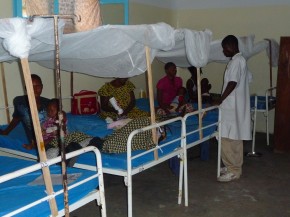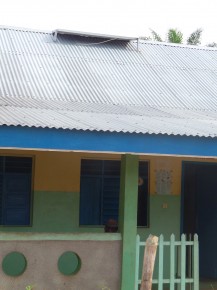Blogging by candlelight seems like a contradiction in terms. But in the city of Kananga – the most Bond villain-sounding of a strong field of Congolese place names – it’s candlelight or nothing. Kananga is a “ville noire” – which roughly translates as a black-out town.While there is a notional electricity network in Kananga, electricity arrives so rarely that no one counts on it. Life either goes on without lights, or is powered by candles or fires for the poor or diesel generators for the better off.
Even the provincial ministries do their business without electricity. Sitting in the waiting room of the Ministry of Health today, I noticed old disconnected wires hanging from walls and ceilings – apart from a single ageing light bulb hanging optimistically over the minister’s desk.
"Black-out hospitals"

I’m here in Kananga, the capital of the province of Kasai Occidental, to help with the design of a major new UK aid programme to improve access to healthcare in the Democratic Republic of Congo (DRC).
My role is to figure out how to equip health centres with renewable energy so they don’t become “black-out hospitals”.
Most health centres in DRC have no source of electricity. Indeed, most people – some 94% of the population – lack electricity. This mirrors a trend across sub-Saharan Africa and Asia, where 1 billion people are still without access to electricity (see infographic at the end of this blog).
Without power, clinics cannot store blood or medicines, and have to close at night. This means that some patients cannot be treated or some births attended – or that treatment can only take place sub-optimally by candlelight.

We believe that equipping health centres with renewable sources of energy will allow longer opening hours, 24/7 staffing, better
access to blood and medicines, and more treatments and attended births. This, in turn, should lead to better health outcomes, such as increased life expectancy.
We need to build the evidence to test this hypothesis. That’s why the UK Department for International Development will undertake a global study to find out what data is out there – or to gather information if we find there are gaps – to tell us what the impact of electricity in clinics and hospitals is on health.
So while I write this blog by the illumination of a guttering flame, I hope that giving birth by candlelight will soon be a thing of the past.
Renewables – very much a part of all of our futures – should give the people of DRC the power to deliver.


8 comments
Comment by Steve Brewster posted on
Vicky … I see that you refer to a large DfID project in the DRC to improve health access. I assume that is the new project won by a consortium headed by IMA? I worked for 9 years with their local affiliate SANRU back in the 80s. At that time we had a significant solar component where we equipped health centers across the country with a simple system for light and running one small refrigerator that was especially designed for vaccines. In fact I was in charge of that program for a few of those years. I imagine that some of that information is still available and maybe you already have it? If not, you can email me if you like and I will put you in touch with those who should still have it. Regards, Steve
Comment by Becky Moor posted on
Hi Vicky & Steve,
It seems to be something has not worked in the projet to supply solar panels to hospitals, if they had them in the 80s and they have nothing now this would seem like a step backwards. I am a strong advocater of access for clean energy for all however I also believe it needs to come with the right training, sense of responsibility and to be completely successful, ownership. We can't simply give away solar panels like giving out blankets. We need long term solutions where by local people and those running the hospital feel a part of something and have a sense of duty. There are many projects out there that offer pay as you go systems, micro grids etc. I would start researching them first.
Best, Becky
Comment by Paul Darrall posted on
I was the electrical engineer for the Kisiizi Hospital hydro-electric project in SW Uganda (see website), and leave UK for Rwanda shortly to commission a similar project near Ruhengeri. I'm interested in helping with technical advice and visiting such places if this would be useful. I have worked in UK electricity distribution for over 40 years, and as a VSO hospital engineer in Mwanza, Tanzania. I have visited Mahagi and Bunia in eastern DRC and speak kiswahili.
The big problem with solar is that lead/acid batteries don't last more than 5 years, even though the panels are fine, though they may need washing to improve efficiency.
Comment by fergus posted on
i built that health centre in 2007. We were meant to build solar electricity and cold chain then with DFID funding, good to see you are still working hard on it in 2012. I need to tell you some funny stories about Kananga
Comment by Samuel posted on
Its a fantastic thing. Why shouldn't health centers and hospitals have renewable energy? It makes sense. Better than backup generators...just have them make their own energy!
Comment by Vicky Seymour posted on
Thanks Paul and Steve for your very helpful comments. We will ask our health programme to follow up with you as they develop their renewables project.
I think Becky you hit the nail on the head when you say that renewables investments aren’t just about installing systems, but about training and ownership above all else. Community and health centre staff involvement and local private sector development will be a key part of what we do here, as well as learning from experience.
Finally, it’s worth noting the sheer scale of the challenge in DRC – even though efforts to provide off-grid power began in the 80s, DRC is so huge and many communities so isolated that coverage is still low. Our programme will work in roughly 10% of the 515 ‘health zones’ into which DRC is split, and will rehabilitate around 10 health centres in each of these zones.
Comment by Louie Ferro posted on
I believe this energy plan would ease the problem of energy in their area. And also should they concentrate on renewable energy such as tesla radiant energy would be helpful to them.
Comment by Graham Knight posted on
Dear All,
I've spent hours trying to find someone responsible for SMALL renewable projects in Africa.
The problem with solar pv, as someone has mentioned, is the battery cost.
Another renewable is biogas which can be employed both for heating and generating electricity.
I've found plenty of references of EU, World Banl, USA funding for projects for getting electricity to the remote poor but can find little evidence that much is happening!
Please help!
Graham K
BioDesign
P.S. There are SMALL biogas projects in the EU for producing electricity!